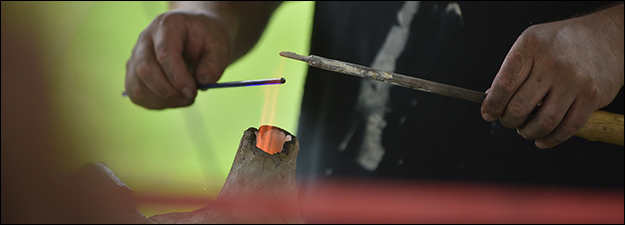Jewish Women in Medieval England (A Roundtable)
Sponsoring Organization(s)
Special Session
Organizer Name
Adrienne Williams Boyarin
Organizer Affiliation
Univ. of Victoria
Presider Name
Ruth Nisse
Presider Affiliation
Wesleyan Univ.
Paper Title 1
The Social Networks of Anglo-Jewish Women
Presenter 1 Name
Charlotte Newman Goldy
Presenter 1 Affiliation
Miami Univ. of Ohio
Paper Title 2
Jewish Women in Medieval England: Unearthing the Records
Presenter 2 Name
Miriamne Ara Krummel
Presenter 2 Affiliation
Univ. of Dayton/Univ. of Michigan-Ann Arbor
Paper Title 3
Finding Jewish Brides in Twelfth- and Thirteenth-Century England
Presenter 3 Name
Ethan Zadoff
Presenter 3 Affiliation
Graduate Center, CUNY
Paper Title 4
Side by Side? Jewish and Christian Women and Convivencia in England, ca. 1100-1290
Presenter 4 Name
Pelia Werth
Presenter 4 Affiliation
Univ. of Leeds
Paper Title 5
The Anglo-Jewess Represented: On the Polemics of Sameness
Presenter 5 Name
Adrienne Williams Boyarin
Start Date
13-5-2016 10:00 AM
Session Location
Bernhard 210
Description
It is generally accepted that there are few post-biblical Jewish women in medieval Christian art. When they are depicted, their Jewishness is usually unmarked; where they appear in narrative, they are often passive or eventual converts; they lack the anti-Jewish stereotypes so often associated with Jewish males. Sara Lipton has argued that this is partly because “the Jewess’s femaleness trumped her Jewishness” (“Where are the Jewish Women?” in Dark Mirror, 2014). At the same time, Jewish women are ubiquitous in the legal and historical records of twelfth- and thirteenth-century England. As Michael Adler put it in 1934, looking primarily at Jewish Exchequer rolls, the Jewess “occupied a position in the life of the Jewry, both within and without the community, probably unequalled in those days in any country” (“The Jewish Woman in Medieval England”). At the same time again, Jewish Studies scholars have had a hard time imagining medieval Anglo-Jewish women’s intellectual and religious lives with any particularity, since most cultural evidence of Jewish life in medieval England was destroyed, carried away, appropriated, or unpreserved after the 1290 Expulsion (e.g., see Elisheva Baumgarten’s introductory notes on the difficulty of using English sources in both Mothers and Children and Practicing Piety). Influential as she was, the medieval Anglo-Jewish woman survives in a complex, limited, and trauma-stained range of sources that are most often (though not exclusively) Christian. Despite the fine work of Adler, Barrie Dobson, and Suzanne Bartlet (among others), it remains the case that she is often studied from or as absence, and there is little awareness of medieval Anglo-Jewish women among scholars of medieval English history and literature generally. This session seeks not only to interrogate the current state of scholarship, but also to explore how multiple sources and disciplines might be creatively employed to develop new readings of the presence, power, and meaning of the Jewish woman in medieval England.
Jewish Women in Medieval England (A Roundtable)
Bernhard 210
It is generally accepted that there are few post-biblical Jewish women in medieval Christian art. When they are depicted, their Jewishness is usually unmarked; where they appear in narrative, they are often passive or eventual converts; they lack the anti-Jewish stereotypes so often associated with Jewish males. Sara Lipton has argued that this is partly because “the Jewess’s femaleness trumped her Jewishness” (“Where are the Jewish Women?” in Dark Mirror, 2014). At the same time, Jewish women are ubiquitous in the legal and historical records of twelfth- and thirteenth-century England. As Michael Adler put it in 1934, looking primarily at Jewish Exchequer rolls, the Jewess “occupied a position in the life of the Jewry, both within and without the community, probably unequalled in those days in any country” (“The Jewish Woman in Medieval England”). At the same time again, Jewish Studies scholars have had a hard time imagining medieval Anglo-Jewish women’s intellectual and religious lives with any particularity, since most cultural evidence of Jewish life in medieval England was destroyed, carried away, appropriated, or unpreserved after the 1290 Expulsion (e.g., see Elisheva Baumgarten’s introductory notes on the difficulty of using English sources in both Mothers and Children and Practicing Piety). Influential as she was, the medieval Anglo-Jewish woman survives in a complex, limited, and trauma-stained range of sources that are most often (though not exclusively) Christian. Despite the fine work of Adler, Barrie Dobson, and Suzanne Bartlet (among others), it remains the case that she is often studied from or as absence, and there is little awareness of medieval Anglo-Jewish women among scholars of medieval English history and literature generally. This session seeks not only to interrogate the current state of scholarship, but also to explore how multiple sources and disciplines might be creatively employed to develop new readings of the presence, power, and meaning of the Jewish woman in medieval England.

